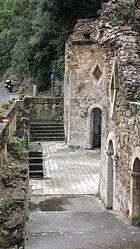You can help expand this article with text translated from the corresponding article in French. (December 2008) Click [show] for important translation instructions.
|
Rennes-les-Bains | |
|---|---|
 The baths | |
| Coordinates: 42°55′11″N 2°19′11″E / 42.9197°N 2.3197°E | |
| Country | France |
| Region | Occitania |
| Department | Aude |
| Arrondissement | Limoux |
| Canton | La Haute-Vallée de l'Aude |
| Government | |
| • Mayor (2023–2026) | Olivier Buscail[1] |
| Area 1 | 18.77 km2 (7.25 sq mi) |
| Population (2021)[2] | 210 |
| • Density | 11/km2 (29/sq mi) |
| Time zone | UTC+01:00 (CET) |
| • Summer (DST) | UTC+02:00 (CEST) |
| INSEE/Postal code | 11310 /11190 |
| Elevation | 254–822 m (833–2,697 ft) (avg. 310 m or 1,020 ft) |
| 1 French Land Register data, which excludes lakes, ponds, glaciers > 1 km2 (0.386 sq mi or 247 acres) and river estuaries. | |
Rennes-les-Bains (French pronunciation: [ʁɛn le bɛ̃] ; Occitan: Los Banhs de Rènnas) is a commune in the Aude department in southern France.
Bathers have enjoyed the natural hot spring waters for thousands of years - they are still used today as a cure for rheumatism and certain skin problems. Today, it is a modern thermal spa with the latest equipment. Due to a microbe found in the piping of the old baths they have been closed and a new hospital built which gets its water from another source. Due to its enormous popularity the 'Bains Forts', an old 'lavoir' where young people have bathed for the last 40 years, have been cemented in and closed indefinitely. This event has led some to rename Rennes-les-Bains, Rennes-sans-Bains.
- ^ "Répertoire national des élus: les maires" (in French). data.gouv.fr, Plateforme ouverte des données publiques françaises. 16 April 2024.
- ^ "Populations légales 2021" (in French). The National Institute of Statistics and Economic Studies. 28 December 2023.



